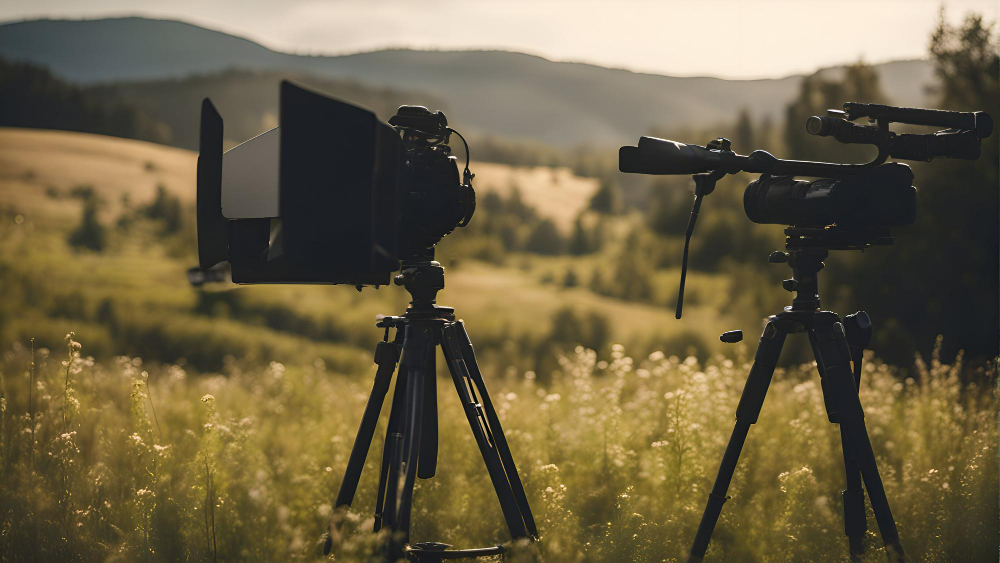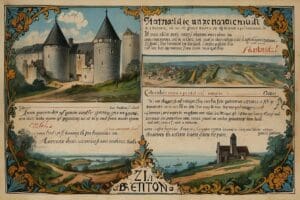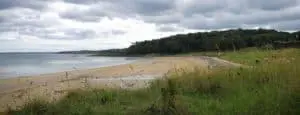Unravelling the Mystery: Where Was The Pale Blue Eye Filmed?

Updated On: March 11, 2024 by Esraa Mahmoud
Have you ever been transported to another time and place while watching a film? The haunting atmosphere, the meticulously crafted sets, and the captivating story all come together to weave a spell, leaving you yearning to step into the world you witnessed on screen.
This is precisely the experience many viewers had while watching The Pale Blue Eye, the chilling gothic thriller starring Christian Bale and inspired by the early works of Edgar Allan Poe. But where did this captivating story unfold?
Contrary to what the film might have you believe, the snowy landscapes and historic buildings weren’t actually located in the 1830s West Point or the Hudson Valley. So, where was The Pale Blue Eye filmed, and what secrets do these real-world locations hold? Join us as we embark on a cinematic journey to uncover the hidden gems and historic towns that brought this captivating film to life.
The Pale Blue Eye Filming Locations!
While the film The Pale Blue Eye transports viewers to the snowy grounds of West Point and the eerily beautiful Hudson Valley in the 1830s, the reality behind the camera is quite different. The film’s production team masterfully transformed various locations across the state of Pennsylvania to create the film’s captivating historical setting. This involved meticulous planning, set design, and a keen eye for detail, allowing the film to capture the essence of the time period. Coming up next, we explore some of the film’s filming locations that you can visit yourself.
Westminster College
Nestled in the charming town of New Wilmington, Pennsylvania, Westminster College offers a unique blend of academic excellence and historic allure. Its picturesque campus, adorned with Collegiate Gothic architecture, has not only nurtured young minds for over 170 years but also attracted the spotlight of Hollywood.
Westminster College is a captivating time capsule, and stepping onto its quad is akin to stepping back in time. The iconic Old Main, Browne and Ferguson Halls, and the McGill Library stand as testaments to the college’s rich heritage, each building boasting intricate details and a sense of grandeur. Exploring the campus allows visitors to soak in the atmosphere of a bygone era, imagining the students who once walked these halls and the stories etched within its walls.
Beyond its historical significance, Westminster College gained recent fame as a filming location for the Netflix movie The Pale Blue Eye. This gothic mystery, starring Christian Bale and Harry Melling, tells the story of a detective investigating a series of murders at West Point Military Academy in the 1830s.
The film crew meticulously transformed the college’s historic buildings, including Old Main, Brown, and Ferguson Halls, to resemble the iconic structures of West Point. Additionally, the college’s quad area, featuring these buildings and the McGill Library, provided the perfect backdrop for several scenes in the film.
The production team went the extra mile by adding period-specific details such as horse-drawn carriages, vintage clothing for background actors, and even recreated military drills on the college grounds, further immersing viewers in the world of 1830s West Point.
Lake Arthur
Located within Moraine State Park, Lake Arthur served as a stand-in for the Hudson River in The Pale Blue Eye. The film crew likely chose this location due to its serene beauty and its ability to capture the film’s desired atmosphere.
The vast expanse of the lake, coupled with the surrounding wooded areas, offered a sense of isolation and mystery, contributing to the film’s suspenseful narrative. Additionally, the film crew likely took advantage of the lake’s various landscapes, capturing scenes on the shoreline, on boats, and potentially even utilising winter’s frozen surface for specific moments in the film.
Allegheny Cemetery
Allegheny Cemetery is a tranquil oasis offering more than just a final resting place. Established in 1844, this sprawling 300-acre expanse transcends the boundaries of a traditional cemetery, captivating visitors with its rich history, captivating landscape, and artistic significance.
Allegheny Cemetery is designated as a National Historic Landmark, and it boasts a unique allure, attracting not only those seeking to pay respects but also history buffs, nature enthusiasts, and even film crews. Its meticulously maintained grounds, dotted with towering trees and winding pathways, provide a serene escape from the city’s clamour. Elaborate mausoleums and sculptures, many in the Victorian Gothic style, stand as testaments to the artistic sensibilities of a bygone era.
The cemetery’s historical significance draws in visitors eager to delve into Pittsburgh’s past. Over 124,000 individuals lie interred here, including prominent figures like industrialist Henry Clay Frick, politician and diplomat Andrew Carnegie, and architect Benjamin Henry Latrobe. Each grave tells a story, whispering tales of the city’s development and the lives that shaped it.
Beyond its historical appeal, Allegheny Cemetery has also gained recognition as a filming location for The Pale Blue Eye, which utilised the cemetery’s evocative atmosphere to set the stage for a chilling murder mystery. The film’s dark and suspenseful tone found a perfect match in the cemetery’s melancholic beauty and the architectural details that cast long shadows and evoke a sense of mystery.
Compass Inn Museum
The Compass Inn Museum isn’t just a historical landmark; it’s a portal to the past. Built in 1799, this meticulously restored stagecoach stop offers a glimpse into the life on the bustling Philadelphia-Pittsburgh Turnpike.
The Compass Inn served as a perfect filming location for the chilling Netflix film The Pale Blue Eye, adding another layer of intrigue for movie buffs and history enthusiasts alike.
As a tourist destination, the Compass Inn Museum immerses you in the 1800s. Costumed docents guide you through the meticulously furnished inn, showcasing period pieces and sharing captivating stories of life on the frontier. You’ll explore the original log structure and the later stone addition and even venture into the cookhouse and blacksmith shop, getting a firsthand feel for the daily routines of the era.
The museum’s authenticity doesn’t stop indoors. Step outside to discover a reconstructed barn and wander through the grounds, imagining the hustle and bustle of weary travellers seeking a warm bed and a hearty meal. Docents often bring history to life with demonstrations of period skills, like blacksmithing or candle making, further enriching the experience.
This historic landmark, built in the early 1800s, underwent a transformation to become “Benny’s Haven,” a tavern frequented by Christian Bale’s character, Detective Augustus Landor, in the film. The museum’s original structure, featuring a large stone fireplace and exposed wooden beams, provided an ideal setting for creating a historically accurate depiction of a 19th-century tavern.
The film crew likely added period-specific furniture, decorations, and props to enhance the tavern’s authenticity further, allowing viewers to step back in time and experience the atmosphere of a social gathering place during that era.
Davis Hollow Cabin
Set in the scenic Moraine State Park in Pennsylvania, Davis Hollow Cabin offers a unique blend of historic charm and outdoor adventure, making it a captivating destination for both tourists and filmmakers alike.
Steeped in history, the cabin dates back to 1780, serving as a stopover for travellers along the North Country Trail. After falling into disrepair, a dedicated group of volunteers meticulously restored it in 2005, preserving its historical significance while transforming it into a functional overnight lodging.
Today, visitors can step back in time and experience the simple life within the cabin’s rustic walls. The spacious interior boasts a full kitchen, two lavatories, a large common area, and a sleeping room capable of accommodating up to eleven guests. Imagine cosy evenings spent sharing stories by the crackling fireplace, surrounded by the tranquillity of the surrounding forest.
Beyond its historical appeal, Davis Hollow Cabin serves as an ideal base for exploring Moraine State Park’s diverse offerings. Hikers can embark on scenic trails, while nature enthusiasts can revel in the park’s abundant flora and fauna. Boating opportunities abound on the park’s lakes, while winter brings a wonderland for cross-country skiers and snowshoers.
The cabin’s historical significance and picturesque setting also attracted Hollywood’s attention. It served as a filming location for The Pale Blue Eye. The film’s dark and suspenseful atmosphere was undoubtedly enhanced by the cabin’s rustic charm and isolated location.
McConnells Mill State Park
Located in western Pennsylvania, McConnells Mill State Park offers a picturesque escape for nature lovers and film enthusiasts alike. Encompassing over 2,500 acres, the park’s crown jewel is the dramatic Slippery Rock Creek Gorge, a National Natural Landmark carved by glaciers thousands of years ago. The gorge boasts towering cliffs, cascading waterfalls, and a rich biodiversity, creating a scene straight out of a storybook.
Beyond its natural beauty, McConnells Mill holds historical significance. Visitors will step back in time by exploring the meticulously restored McConnell’s Mill, a 19th-century gristmill that once served the local community. The adjacent covered bridge, built in 1874, adds to the park’s charm and historical ambience.
This captivating scenery wasn’t lost on the filmmakers of The Pale Blue Eye. The 2023 psychological thriller utilised McConnells Mill as a key filming location. The park’s rugged terrain and historical elements provided the perfect backdrop for the film’s setting, a remote military academy in the 1830s.
Old Economy Village
The Old Economy Village is a charming historical site that transports visitors to the 19th century. This National Historic Landmark, meticulously preserved by the Pennsylvania Historical and Museum Commission, offers a glimpse into the unique world of the Harmony Society, a thriving religious community founded by German Lutheran separatists.
Old Economy Village has also garnered recent attention as a filming location for the psychological thriller The Pale Blue Eye. The film’s setting, West Point Military Academy in 1830, found its perfect double in the village’s well-preserved buildings and serene atmosphere.
For tourists seeking a unique experience, Old Economy Village offers a captivating journey through time. Visitors can explore over 20 restored buildings, including the Grand Economy House, once the communal residence of the Harmonites, and the Gemeinhaus, the heart of their religious and economic life. The beautiful Harmony Society gardens, bursting with colourful blooms, offer a peaceful escape and a glimpse into the community’s commitment to self-sufficiency.
Penguin Court
Nestled amidst the rolling hills of western Pennsylvania lies Penguin Court, a captivating historical estate that boasts both intriguing history and a surprising connection to the silver screen. While the 1,100-acre property isn’t open to the public every day, it offers unique opportunities for history buffs and movie enthusiasts alike.
The name “Penguin Court” might raise eyebrows, but its origins are far more terrestrial than aquatic. Named for the ten penguins that once roamed the grounds as part of a private menagerie, the property was eventually acquired by the Brandywine Conservancy, a non-profit organization dedicated to historic preservation.
For visitors, the charm of Penguin Court lies in its unique blend of historical elements and natural beauty. The estate boasts remnants of a once-grand mansion, hinting at its extravagant past. A historic barn stands sentinel, a testament to the area’s agricultural roots. But the true star of the show is the sprawling landscape. Lush forests and open meadows offer a tranquil escape, perfect for hiking, birdwatching, and simply soaking in the serene atmosphere.
Penguin Court has also become a sought-after filming location. The film The Pale Blue Eye used the estate’s diverse landscape and historical backdrop to create a chilling and atmospheric setting for its 1830s murder mystery. The film’s portrayal of the surrounding forests and meadows evokes a sense of isolation and mystery, mirroring the film’s plot.
The Pale Blue Eye captivated audiences with its chilling story and evocative setting. While the film transported viewers to 1830s West Point and the Hudson Valley, the real magic happened in Pennsylvania. The state’s diverse landscapes, from the historic architecture of Westminster College to the serene beauty of Lake Arthur, provided the perfect backdrop for the film’s narrative. Each location wasn’t just a visual setting; they played a crucial role in creating the film’s atmosphere, suspense, and historical accuracy.






